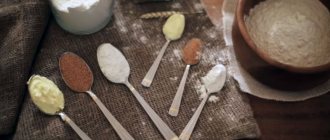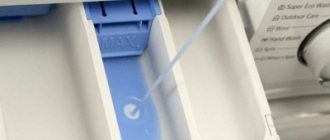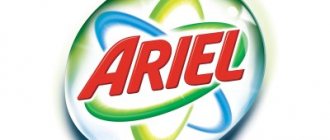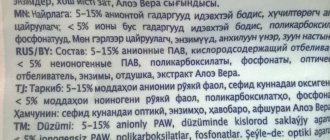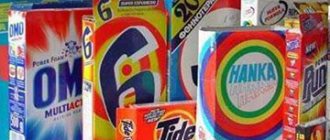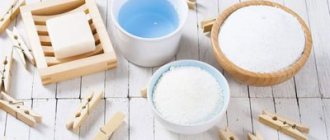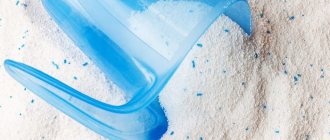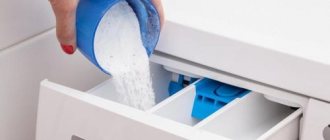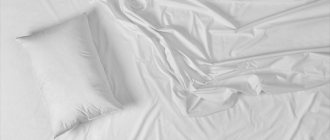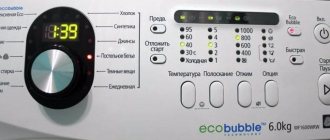Washing powder is still the most popular means for washing all kinds of things in a washing machine and by hand, so many housewives will find it useful to know how many grams of washing powder will fit in a teaspoon and a tablespoon, and how it can be quickly measured without scales using just spoons at home.
Important: below are the data for spoons with powder without a heap, since when you put washing powder into a spoon with a heap, the accuracy of measurement is significantly reduced (the volume of the heap may be different for everyone, especially if the powder is a little damp - in this case the heap can be 3 -5 times the volume of a spoon).
Why measure out powder?
Why you need to accurately measure SMS (synthetic detergent):
- Saving. When using concentrated products, it is easy to make big mistakes. If you put a lot of powder, washing will cost more.
- Washing quality. If, due to the underweight of the product, the dirt cannot be washed off the first time, you will have to start the SMA again, again wasting water and electricity.
Manufacturers of powders and gels can add measuring spoons or cups to the product kit, but only some SMS are equipped with them. If the dosage is indicated on the package in grams, you have to measure out the required amount. You can use scales, but not every kitchen has them and not everyone wants to bother with them. It’s easier to use a spoon or “Tide” - because it’s always at hand.
In cooking and folk medicine, a teaspoon or a tablespoon is a favorite measure of weight and volume indicated in recipes. It is easy to find tables on the Internet that indicate the weight of various substances measured with spoons - salt, soda, pepper, etc. And we will learn how to measure the required amount of SMS with them.
How many grams in spoons table
Measurements of products in grams are used in order not to oversalt the dish, and also not to oversweet it. Typically, recipe authors indicate the weight of food using a small heaped spoon. Sometimes recipes with a flat spoon are used, but the author must indicate this. The weight measure in our table is indicated in the generally accepted spoon with and without a slide.
( Also read: how many grams are in a glass?).
How much laundry detergent is in a tablespoon?
1 tablespoon of powder contains 25 grams. It is most convenient to scoop out the powder if the dose is 50 or 100 grams. Then you will need to put 2 or 4 tbsp. l. respectively.
Other cutlery is also used for measuring:
- A teaspoon contains 5 grams.
- In the dessert room - 10 grams.
These measuring devices are convenient to use - they can be used to easily measure round numbers.
How many grams in a teaspoon table
If 1 teaspoon of flour is indicated, then this means a slightly heaped spoon. Accordingly, recipes may also prescribe 1 small level spoon of flour, then that’s how it should be.
Bulk products
| Product | No slide | With a slide |
| Cocoa powder | 9 | 12 |
| Buckwheat | 7 | 10 |
| Starch | 6 | 9 |
| Dry mustard | 4 | 7 |
| Dry yeast | 5 | 8 |
| Raisin | 7 | 10 |
| Gelatin | 5 | 8 |
| Ground cinnamon | 8 | 12 |
| Ground coffee | 7 | 9 |
| Instant coffee | 4 | 5 |
| Cereals (barley, pearl barley) | 8 | 11 |
| Cornflakes | 2 | 4 |
| Lemon acid | 5 | 8 |
| Poppy | 8 | 12 |
| Semolina | 8 | 12 |
| Powdered milk | 12 | 14 |
| Potassium permangantsovka | 15 | 18 |
| Flour | 9 | 12 |
| Cereals | 6 | 8 |
| Nuts | 10 | 13 |
| Ground pepper | 5 | 8 |
| Rice | 5 | 8 |
| Baking powder | 5 | 8 |
| Rock salt | 8 | 12 |
| Sugar (and its powder) | 7 | 10 |
| Soda | 7 | 10 |
| Extra salt | 7 | 10 |
| Ground crackers | 5 | 7 |
| Sorbitol | 5 | 7 |
| Dry cream | 5 | 6 |
| Dry mashed potatoes | 10 | 12 |
| Beans | 10 | 12 |
| Medicinal herb | 2 | 3 |
| Lentils | 7 | 9 |
| Egg powder | 10 | 12 |
| Tea | 2 | 3 |
Liquid products
Liquid products (water, milk, vinegar) need to fill the spoon completely. It is worth noting that the grams given are relative, so if you need to know the exact weight, it is better to use an electronic or kitchen scale.
| Product | gram |
| Peanut paste | 8 |
| Water | 5 |
| Jam | 17 |
| Red caviar | 7 |
| Potassium permangantsovka | 5 |
| Honey | 10 |
| Mayonnaise | 10 |
| Liquor | 7 |
| Whole milk | 5 |
| Condensed milk | 12 |
| Vegetable oil | 5 |
| Butter | 5 |
| Melted margarine | 4 |
| Fruit puree | 17 |
| Sour cream | 10 |
| Cottage cheese | 4 |
| Soy sauce | 5 |
| Tomato paste | 5 |
| Apple vinegar | 5 |
How many spoons of powder should I pour into the washing machine?
To calculate the number of spoons - tea spoons, dessert spoons or table spoons, you need to have three data:
- how many grams are in one spoon - we have already clarified this question;
- dosage specified by the manufacturer;
- drum volume.
If you read the instructions for the detergent, you can find instructions on how many grams to put in 10 liters of water. Considering that different amounts of water are used for washing, you have to make a small calculation. Modern SMAs provide automatic measuring of everything - water and powder, according to the weight of the loaded laundry. If you have to measure SMS yourself, the easiest way is to listen to the advice of experts; they recommend:
- Place 40 grams per 6 kg load. It is most convenient to use the dessert version - you will need to measure 4 pieces. This volume also corresponds to 8 tsp.
- For 1 kg of laundry, sprinkle 1 tbsp. l. no slide. If the water is hard, increase the dosage by 20 grams.
Video on how to weigh food without scales at home
Last year was a very fruitful year for apples and my friends brought a lot of apples from the dacha and I had to somehow determine how many kilograms of delicious gifts I had. But there are no such scales at home, so I found on the Internet an interesting way to weigh food without a kitchen scale. Using water and two pans.
Take a look, maybe it will be useful to you too!
You can also prepare delicious dishes without using a kitchen scale by knowing the average weight of a number of products. For example:
- small chicken egg – 50-55 g;
- protein – 35 g;
- yolk – 15 g;
- medium chicken egg – 55-65 g;
- large chicken egg – 65-70 g;
- medium potato tuber – 150-200 g;
- small garlic clove – 5 g;
- medium onion – 150 g;
Why is an overdose of SMS unprofitable?
If you read what is written on the package, it is easy to get confused and make mistakes. There is an opinion that manufacturers deliberately inflate doses so that consumers use up the pack as quickly as possible. In this simple way, the manufacturer increases income by about 10%.
It is not advisable to exceed the dose, things will not wash out better, but the negative consequences of an overdose will be:
- Rinsing dry matter is always a difficult task, and if it is put in excess, it becomes much more complicated. And if you don’t turn on an additional rinse - and this again means extra consumption of water and electricity, then white stains will appear on the fabric - signs of an overdose.
- A chemical “amber” will “start up” inside the drum. It persists for a long time, being transferred to the laundry during subsequent washes.
- The tray is clogged.
Liquid and viscous products
Products in liquid form are measured in either milliliters or grams. Both of these measures can be found in culinary recipes. In a tablespoon, the volume (ml) and weight (g) of many popular liquids in cooking have long been determined and summarized in tables. The hostess can only look into them and use this cutlery to measure the required amount for her dish - be it in milliliters or grams.
Here is a table of the content of liquids and viscous products in a tablespoon in grams. It will not be possible to pour liquid into a spoon above its edges, so the maximum amount of food is limited to these edges. But some viscous ingredients can be placed in heaps, for example, thick honey or homemade high-fat sour cream. This is why the table below shows two weights for viscous products.
Not all that glitters is gold: how to make silver and cupronickel cutlery shine
Table of the weight ratio of liquid and viscous products contained in a tablespoon, in grams.
| Products | grams in tablespoon | Maximum total number of products |
| Water | 18 | — |
| Raw milk | 20 | — |
| Condensed milk | 28 | — |
| Vinegar | 15 | — |
| Melted butter | 17 | — |
| Melted margarine | 15 | — |
| Vegetable oil (sunflower) | 17 | — |
| Liquid fat | 20 | — |
| Liquid jam (average) | 35 | — |
| The jam is thick (on average) | 45 (without slide) | up to 60 |
| Liquid honey | 35 | — |
| Honey is thick | 50 (without slide) | up to 70 |
| Heavy cream | 30 (without slide) | up to 50 |
| Thick sour cream | 30 (without slide) | up to 50 |
| Low-fat sour cream | 25 | — |
| Mayonnaise | 20 (without slide) | 30 |
| Tomato paste | 30 (without slide) | 40 |
| Cottage cheese (on average) | 20 (without slide) | 35 |
It should be said that a standard measuring tablespoon is taken to be a product whose scoop length is 7 cm, and the width of its widest part is 4 cm. This is the kind of spoon that is mentioned in cooking. If anyone does not know whether there is a standard spoon at home, then you can take any other one and measure it by placing or pouring the product into some vessel whose volume is known. By counting the number of spoons required to fill the vessel, it is easy to find out how much product in grams fits in 1 spoon of a given type.
Frequently asked questions
Users who do not understand weights and measures often encounter problems when measuring detergents. They have questions:
- Users often ask whether 10, 30 or 50 mg is how many teaspoons? You should remember how many milligrams are in 1 gram. One gram contains 1000 mg, so to measure out this amount of product, you will most likely need a knife. 50 mg = 0.05 g, this is a hundredth part of 1 tsp. This amount is usually about.
- 30 grams of powder is how many spoons? The answer is, depending on which ones. If there are tea glasses, then 6, if dessert ones - 3. With table drinks it is more difficult - you need to measure one incomplete, without 5 g.
Bulk products
It should be noted that a tablespoon as a measure of weight for various substances differs little in accuracy from the same mechanical or electronic devices that exist in a modern kitchen. To determine the weight of bulk products, two quantities are used:
- when the spoon is filled only to the brim (without a slide);
- when the maximum amount of food (with a slide) is placed in the spoon.
The cook himself chooses how to measure the required amount of a particular product, filling the spoon with a heap or not. It depends on exactly how many grams he needs for the dish he is preparing. Sometimes it is more convenient to take the weight with a slide for calculation, and in other cases - without it.
Table of the weight ratio of bulk products contained in a tablespoon, in grams.
| Products | Weight in st. heaped spoon (g) | Weight in st. level spoon (g) |
| Sugar/Powdered sugar | 25/30 | 20/25 |
| Citric acid in crystals | 16 | 12 |
| Rock salt (coarse) | 30 | 25 |
| Fine salt (extra) | 28 | 22 |
| Round rice | 20 | 16 |
| Dry buckwheat | 25 | 20 |
| Millet | 25 | 20 |
| Wheat flour | 25 | 20 |
| Baking soda | 28 | 22 |
| Ground coffee | 20 | 15 |
| Gelatin granules | 15 | 10 |
| Starch | 30 | 20 |
| Semolina | 25 | 20 |
| Cocoa powder | 25 | 20 |
| Hercules | 14 | 10 |
| Ground crackers | 15 | 12 |
Washing parameters and dosage
The amount of detergent required for high-quality washing of stains is influenced by the following factors:
- Temperature. Hot water means less SMS consumption.
- Degree of pollution. Dirtier laundry means more dose.
- Hardness of water. Hard water - high doses.
- Amount of laundry . More loading - more SMS for washing.
- Water consumption per cycle. As water consumption increases, SMS consumption increases.
- Washing program and fabric type. Selected individually. It is recommended to wash wool and silk with special products.
It is always useful to know how much of a particular substance is contained in the most popular cutlery. A simple spoon can be useful in a variety of situations. When placing SMS into a cuvette, try not only to measure the dose correctly, but also take into account as many factors as possible that influence the wash.
True Powder Dosage
In general, it is better to read dosage recommendations not on the packaging of the powder or in the instructions for it, but from independent sources. Because on average, manufacturers overestimate the required dose of powder by 10%-15% in order to increase their profits. Therefore, you will have to find out the optimal parameters for you personally.
We repeat again, do not try to play it safe and pour as much powder into the compartment as possible. This will not make things cleaner, and there are several other negative consequences:
- it is extremely difficult to rinse dry powder, and even in large quantities, resulting in whitish stains on clothes;
- an unpleasant smell of chemicals in the drum, which will not disappear and will remain on other things;
- tray clogged.
In addition, washing parameters play a huge role in dosage. For example, temperature, type of fabric, nature of contamination and other conditions. With experience, housewives quickly figure out how much powder is needed in a given case, so don’t worry. Through trial and error, you will sooner or later determine the optimal volumes.
One rule always works for any fabric and any washing program: the higher the water temperature, the less powder. If you wash at 30 degrees with rinsing, the dose can be increased.
Interesting:
- Dishwashers for dining rooms
- Washing powder consumption per 1 kg of laundry in a washing machine...
- How much powder should I put in the washing machine?
- How to wash kitchen towels - no stains!
- How much does a dishwasher weigh?
- What brand of washing machine should I buy?
Reader comments
- Share your opinion - leave a comment
Dishes capacity
At a hardware store you can purchase special containers made of transparent plastic or glass, on the walls of which the weight measures in grams of liquid and bulk products will be written.
If you don’t have such utensils, just use any cup whose volume you know for sure. For example, you have a bowl with a volume of 100 grams, and you need to measure 50 grams. Then just fill this bowl halfway and get the required amount of product.
Frozen with hand
There is a good folk method that will help solve the problem of how to measure grams without scales. This method will be convenient for those who do not want to exhaust themselves with mathematical calculations. The disadvantage of the method is only an approximate result.
- If you need to measure a piece of fish or meat of 100 grams, then look at the woman’s palm - both the size and thickness will correspond to 100 grams. If we take a man’s hand as an example, then we add 50 grams.
- If you need to measure a portion of cereal, then 200 grams will be equal to the size of a woman’s fist and approximately 250-280 to the size of a man’s.
Washing machine cycles and powder
There are several factors that determine how many grams of product are needed for a particular wash. The main ones:
- the degree of contamination of things and existing stains;
- hardness of the water used for washing.
When using hard water, use special products that contain a softening agent.
- Benefits, harms, nutritional value, calorie content of sour cream per 100 grams, 1 tablespoon, 1 teaspoon
Washing powder dosage
The dosage of washing powder depends on the following factors:
- how much laundry will be loaded for one wash;
- how much water is consumed during one wash;
- what washing machine mode is used;
- type of fabrics.
For washing delicate items, silk and woolen fabrics, it is recommended to use special chemicals.
How to dose washing powder
The table shows the ratio of powder norms based on the loading volume of the washing machine.
Stain removers are used to remove stains of various types. If the fabric is white, use oxygen bleach.
Cup for measuring flour
If you have an ordinary cut glass in your kitchen, it will become a real assistant when measuring food. Its volume is 250 ml up to the rim, and this is suitable for measuring liquids. As for flour, we need to measure grams, and this is done in the following way:
- Using a spoon, carefully fill the glass to the rim. There is no need to shake and press the flour; the weight will increase significantly. Spread the product evenly over the rim and you'll have almost exactly 160 grams.
- If you fill the glass to the very brim, it will be 180 grams.
- In the case where there is a glass with only 200 ml volume, the weight will be 130 grams when filled to the rim.
This is how flour is measured in glasses. Many people make the mistake of thinking that a 200 ml glass holds 200 grams of flour, and add that much when preparing a dish. Grams and milliliters are different things. Milliliters are used to measure liquids that are denser than bulk solids.
How much liquid powder should I pour into the machine?
Many of them have practically established that to effectively wash clothes, it is enough to add 2-3 tbsp. l. facilities. This quantity is suitable for machines with a load of 5–6 kg and a water consumption of 35–50 l.
Interesting materials:
What kind of sand for art concrete? Which beach is on the Black Sea? What approach allows us to highlight the main results of training and education in the context of key tasks? Which train is considered high speed? Which pole of the magnet is positive? Which peninsula is the largest in area Arabian Indochina Kamchatka? What breed is the cat Matroskin? What breed is the Crookshanks? What constant morphological feature does the adverb have? What was Valentina Vladimirovna Tereshkova’s call sign?
How to quickly calculate the required number of grams for cooking
Almost all novice cooks are at a loss when it comes to preparing a dish according to the directions in the recipe. It’s good if the quantity of products is indicated in Art. or teaspoons. Difficulties arise when the recipe contains grams. But there is a way out, and even several:
- Cooking calculator. This is a convenient service in which you need to specify grams and get the equivalent in glasses, spoons, etc. For example, to understand how many st. l. is 40 grams of flour, it is enough to indicate the type of product and its weight in the appropriate columns, and the calculator will determine its quantity in a century in a matter of seconds. l.
- Culinary table of measures. The table shows grams of salt, cereals, flour, vanilla, which most often have to be measured when preparing dishes. And in the column on the left the amount of st. corresponding to the weight is written. l.
Culinary table of measures
| Products | Weight | Number of st. l. |
| salt | 25 grams | 1 without slide (b/g) |
| 40 g | 1 b/g plus ½ s/g | |
| sugar | 20 gr | 1 b/g |
| 80 grams | 4 b/g | |
| vinegar | 10 grams | 2 (in tsp) |
| 15 g | 1 | |
| potato starch | 20 g | 1 b/g |
| 30 grams | 1 s/g | |
| water | 50 g | 3 |
| 60 g | 3 tbsp. plus 2 hours | |
| mayonnaise | 20 g | 1 b/g |
| 80 g | 2 s/g plus 1 b/g |
No baked goods are complete without flour. To measure the required amount of product, you should remember that 20 grams of flour corresponds to 1 tbsp. l. b/g.
If the calculations seem complicated or relative, it is worth purchasing a measuring cup, or even better, an electronic scale. But even here it should be remembered that the weight of bulk hygroscopic products depends on air humidity. The higher it is, the more weight the powder products acquire.
